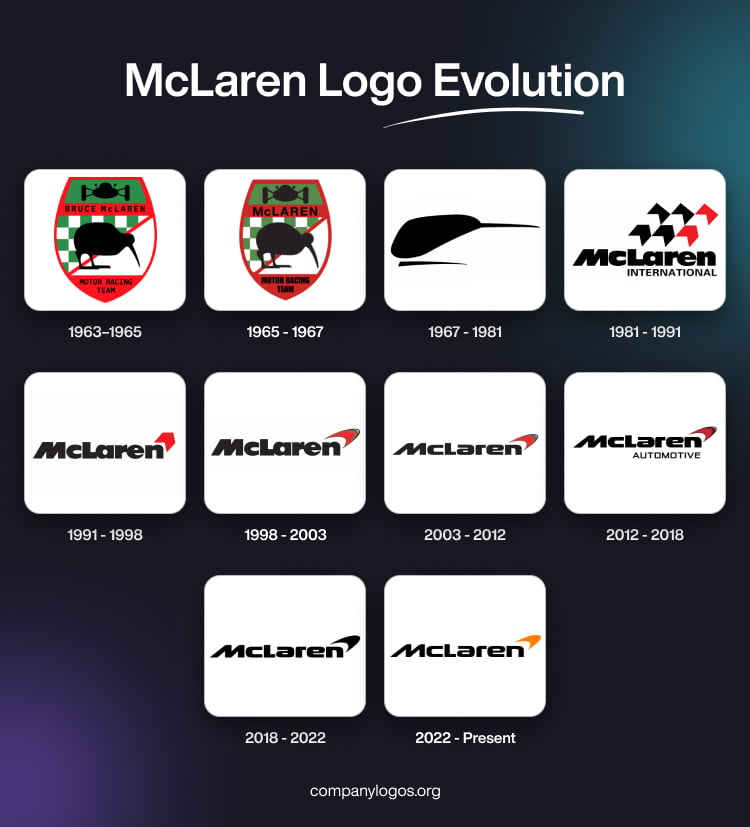
McLaren is a world-renowned name in the realms of motorsport and high-performance automotive engineering. Founded in 1963 by a New Zealand racing driver, Bruce McLaren, the company has grown from a small racing outfit into one of the most successful Formula 1 teams in history and a leading manufacturer of cutting-edge supercars. With a reputation built on speed, precision, and innovation, McLaren has consistently pushed the boundaries of technology. Its dominance in Formula 1 is associated with legendary drivers like Ayrton Senna and Lewis Hamilton.
The McLaren logo has undergone various transformations since it was conceived in 1963. The logo iterations show the journey of the brand as a premier sports car and its commitment to excellence and innovation in the automotive industry. The article delves into the evolution of the McLaren logo, among other details of the company.
The Genesis of the McLaren Logo (1963–1965)
The original McLaren logo featured a red shield with a chequered flag in green at the top and a diagonal red line across the shield. A black silhouette of a Kiwi bird with her head down was meant to show she was looking for something. The image of the Kiwi bird was a nod to the legacy of Bruce McLaren, the founder. In the bottom section of the shield lay a solid red segment with the words “MOTOR RACING TEAM” in black uppercase. Near the top of the shield was written the name of the founder in black against a horizontal red banner. The top section of the shield had the silhouette of a racing car against a green background.
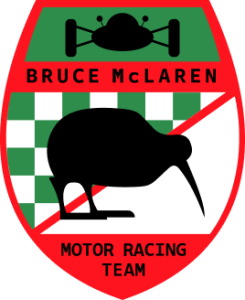
(1965 – 1967)
The second logo iteration in 1965 was almost the replica of the original logo, but with the change in lettering. The name of the founder at the top in the earlier logo was replaced with the wordmark “McLAREN”. The size of the wordmark “MOTOR RACING TEAM” in two levels was considerably bigger than the previous iteration.
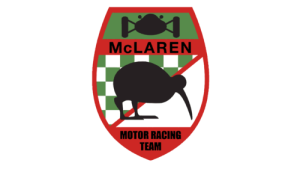
(1967 – 1981)
Nicknamed Speedy Kiwi, the logo of 1967 showed the image of the bird in a stylish and modern way. The black silhouette had an elongated sharp beak with a pointed line at the bottom.

(1981 – 1991)
The 1980s ushered in a significant era for McLaren as it entered into a partnership with Marlboro. This collaboration had a profound impact on the logo, which became a canvas for intricate designs. It blended the essence of McLaren with the branding demands of Marlboro. Designed by Raymond Loewy, the Kiwi bird was replaced in this iteration with a checkered pattern in black, red, and white, as a tribute to the Marlboro sponsorship. Below the pattern was written a thick black wordmark “McLaren INTERNATIONAL” in two levels.

(1991 – 1998)
In the 1991 logo the checkered pattern was replaced by a red triangular arrow or a red chevron. The colour of the logo remained the same, while the typeface was slightly refined. Also, the word “INTERNATIONAL” was removed.
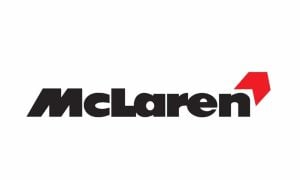
(1998 – 2003)
In the 1998 logo iteration, the red chevron was replaced with a swoosh symbol. The wordmark was written using both bold and soft lines.
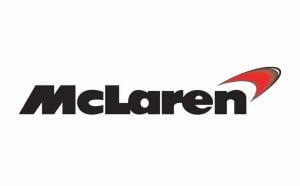
(2003 – 2012)
In the 2003 logo update, only the typeface was changed. The letters feature more elegant lines and are rounded to symbolise the successful running of racing cars.
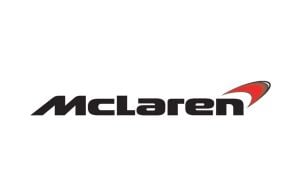
(2012 – 2018)
In 2012, the company was renamed to McLaren Automotive, which necessitated a logo change. However, not much was changed, but for the addition of the word “Automotive” in a different font.

(2018 – 2022)
The 2018 logo was modern, stylised, and simple. It depicted the wordmark “McLaren” in a sleek, custom sans-serif typeface in black to emphasise the sophistication and progressive nature of the brand. The key element in the logo was the stylised swoosh-like element in black to the top right corner of the letter “n”. Symbolising forward movement, the swoosh-like element represented the brand’s drive for speed, victory, and dynamism.
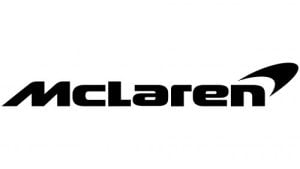
(2022 – Present)
The latest logo was introduced in 2022 and was designed by Miles Newlyn. It retained the previous logo design, but for the colour of the swoosh, which was changed from the previous black to orange.

The Elements of the McLaren Logo
Font
The McLaren wordmark is written using a custom sans-serif typeface where the heavy title case letters have smooth shapes. The fonts similar to the McLaren typeface include Snasm Heavy, Serene MTC, and Strelka Ultra. Also, the logo designers chose the vector version of Marcus Sterz’s Moki Lean typeface.
Colour
The colour palette of the McLaren logo comprises black, white, and red. The choice of colours conveys a sense of professionalism, open-air performance, and engineering excellence.
The History of McLaren
McLaren is one of the most legendary names in motorsport and high-performance automotive engineering. It boasts a proud history spanning over six decades. The company was founded in 1963 by a New Zealand racing driver Bruce McLaren, who had already made a name for himself as one of the youngest winners in Formula 1 at the time. His vision was to create a team that would design, build, and race its own cars. It was a bold move in an era when most teams bought cars from established car companies.
In 1966, McLaren entered Formula 1 as a car company. The team’s first major breakthrough came in the 1968 Belgian Grand Prix, when Bruce McLaren himself drove the M7A to victory. This marked McLaren’s first Formula 1 win and established the team as a rising force in motorsport. Beyond Formula 1, McLaren also gained success in the Can-Am series in the late 1960s, as it dominated with powerful sports cars and became a benchmark for engineering excellence.
However, tragedy struck in 1970 when Bruce McLaren was killed while testing a car at Goodwood. Despite this, the team carried on to honour his vision. Under the leadership of Teddy Mayer and later Ron Dennis, McLaren grew into a powerhouse. The 1980s and 1990s are considered the golden era of McLaren. Partnering with TAG-Porsche and later Honda, McLaren produced legendary cars such as the MP4/2, MP4/4, and MP4/6. Drivers like Niki Lauda, Alain Prost, Ayrton Senna, and Mika Häkkinen delivered multiple World Championships. In fact, the 1988 season was especially dominant with the brand winning 15 of 16 races.
Parallel to racing, McLaren entered road car development. In 1992, it launched the McLaren F1, which was a revolutionary supercar designed by Gordon Murray. It was the world’s fastest production car for years and is still regarded as one of the greatest cars ever built. This venture laid the foundation for McLaren Automotive, the company’s road car division.
In the 2000s, McLaren continued as a major force in Formula 1, as it won the 2008 Drivers’ Championship with Lewis Hamilton. However, the following decade was challenging, with struggles in performance, particularly during the partnership with Honda between 2015–2017. Still, the team gradually rebuilt its competitiveness in the 2020s. It scored podiums and a victory in Monza 2021 with Daniel Ricciardo.
On the automotive side, McLaren Automotive was officially established in 2010 and quickly became a leading supercar manufacturer. Cars like the MP4-12C, P1 hybrid hypercar, 720S, and Artura showcase McLaren’s continued focus on lightweight engineering, aerodynamics, and racing-inspired design. McLaren represents a unique blend of motorsport heritage and cutting-edge automotive technology. The brand stands for innovation, performance, and the spirit of its founder, Bruce McLaren, whose legacy continues to drive the company forward.
Interesting Facts About McLaren
- McLaren was founded in 1963 by a New Zealand-born race car driver Bruce McLaren, who was just 26 years old at the time.
- McLaren is one of the most successful Formula 1 teams in history, with over 180 Grand Prix wins and multiple Constructors’ and Drivers’ Championships.
- In 1981, McLaren revolutionized Formula 1 with the MP4/1, the first F1 car built with a carbon-fiber monocoque. It set a new standard for safety and performance.
- Launched in 1992, the McLaren F1 was the world’s fastest production car at the time, reaching 240.1 mph (386.4 km/h). It also featured a unique three-seat layout, with the driver in the center.
- McLaren had a long and successful partnership with Mercedes. They produced iconic cars like the Mercedes-Benz SLR McLaren in the early 2000s.
- In 2013, McLaren introduced the P1, one of the first hypercars with hybrid technology. It blended electric power with a twin-turbo V8 engine for breathtaking performance.
- McLaren’s racing cars are often seen in Papaya Orange, a color first used by Bruce McLaren in the 1960s and revived as a tribute to its heritage.
- The futuristic McLaren headquarters in Woking, UK, was designed by Norman Foster. It features pristine labs, wind tunnels, and even an artificial lake for cooling.
- McLaren cars frequently appear in films and video games, with the McLaren F1 and P1 being among the most celebrated on-screen supercars.
- McLaren also works in aerospace, healthcare, and cycling through McLaren Applied Technologies.
Finally
The McLaren logo and its iterations stand as a testament to the brand’s journey over the decades. These show how the brand with humble beginnings had, over the years, transformed into a marquee race car brand known for resilience, power, performance, and adaptability.